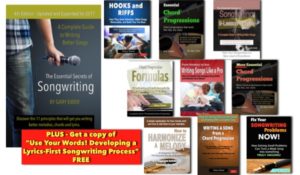The bridge of a song typically happens after the second chorus. There are lots of reasons you might use a bridge:
- To introduce a new melody.
- To introduce a new key area.
- To complete the lyric (where the bridge is followed by chorus repeats.)
- To extend the length of your song.
Most of the time, a song’s bridge will either change key, or at least start on a non-tonic chord. In any case, there’s usually no mistaking a bridge: it usually sounds different from everything else, mainly because the melody is usually different.
 Songwriters are very familiar with the chorus hook, but there are other kinds to experiment with, and you will want to discover the power of layering various kinds of hooks in the same song. “Hooks and Riffs: How They Grab Attention, Make Songs Memorable, and Build Your Fan Base“ shows you how it’s done.
Songwriters are very familiar with the chorus hook, but there are other kinds to experiment with, and you will want to discover the power of layering various kinds of hooks in the same song. “Hooks and Riffs: How They Grab Attention, Make Songs Memorable, and Build Your Fan Base“ shows you how it’s done.
But here’s another option that’s worth considering for your song’s bridge: make it an instrumental version of the verse. If you’re not sure what this might sound like, or what it would do for your song, it’s the option Chicago chose in their 1982 hit “Love Me Tomorrow” (Peter Cetera/David Foster).
After the second chorus, we get what sounds like a verse 3, but the first part of it is purely instrumental. No change of key, no lyrics… just apparently an attempt to gain some mileage and make the song longer to fit the expectations of hits songs at that time. The lyric starts up again for part 2 of the verse.
It’s hard to say why this option might work in some songs and not in others. About the only thing it has that’s related to normal bridges is that it extends the length of a song. But there’s no new lyric, no new key, no new melody.
It may be because there’s already a key change ( a non-standard one) in this song, with the verses in Gb major and the chorus in Eb major. So maybe the thought was that a further key change would destabilize the song’s harmonic structure.
And the fact that the verse uses a 2-part structure, with part 1 in major and part 2 in minor, perhaps made a key change similarly unnecessary.
In any case, in your own writing, if you’re looking to make your songs longer, but don’t want the “clutter” of a normal bridge section, you might want to consider something simple: an instrumental version of your verse as a replacement for the bridge.
 Written by Gary Ewer. Follow Gary on Twitter.
Written by Gary Ewer. Follow Gary on Twitter.
 “The Essential Secrets of Songwriting” 10-eBook bundle includes several chord progression eBooks, including “Chord Progression Formulas”. Learn how to create chord progressions within seconds using these formulas.
“The Essential Secrets of Songwriting” 10-eBook bundle includes several chord progression eBooks, including “Chord Progression Formulas”. Learn how to create chord progressions within seconds using these formulas.










